
Sam Zell the Billionaire who owned and destroyed properties, newspapers and generally made those whose lives he touched through his reverse Midas one, is dead. May there be a special place in hell for him.
To know who Sam Zell is you have to look at his wealth and how he accumulated it over his lifetime. He did it by buying distressed properties and largely maintaining them the same way, only charging inordinate amounts of rent in the process. There is a lawsuit pending here in Jersey City over the Equity properties that have made life untenable for many residents, not the first nor the last for excessive fees or costs. All of this tied to a Pro Publica article about Real Page Analytics, used onn properties owned by Zell , and many others with regards to rent inceases in properties across the country.
While the focus on multi family units is one of Zell’s investment, he also owned trailer parks. For the record Berkshire Hathaway, the beloved Billionaire Warren Buffet is another who owns similar properties and many of those residents feel the same way about him as they do Zell. This is also true of the Kushner family, nee of Jared who made their real estate fortune as slumlords in Baltimore.
Anyone who knows the procedure of how these men accumulated their fortunes need to understand that it came at a price for those whose livelihoods and businesses were tied to them and in turn exploited by them when the opportunity arose. A rising tide lifts all boats and these men are just examples of how rising tides crashes and damages property in its wake. But hey its all fair in war and Capitalism.
The story below is from The Guardian regarding Zell’s approach to property maintenance. As in none. There is how you make a profit, you buy low, sell high and in the interim do as little as possible. See try that in your own home, let me know how it works out.
‘It’s hell’: life under the American mobile home king who calls himself a ‘grave dancer’
Billionaire Sam Zell is the largest mobile home landlord in the US, but his tenants say they reckon with disrepair, neglect, flooding and rising rents. Some have had en
by Michael Sainato in Tampa, Florida, with photographs by Tina Russell
The Guardian May 2023
Down Yonder mobile home park bills itself as “downright relaxing”. Located a few miles from the beaches of the Tampa Bay area, the 362-unit community touts numerous amenities for its residents such as a clubhouse, pool, hot tub, shuffleboard courts and warm weather.
These are what drew Colleen Gartner, 51, who moved to the park from Pennsylvania in November 2020 after being forced into retirement due to a disability. Like many Americans living in the north, she dreamed of getting away from cold winters and a retirement someplace warm.
“I came down here, looked at homes, loved the layout of the park, purchased and moved,” she said. “Expecting since my children were grown and I was single for the first time in my life, I thought I was going to retire and enjoy the sun for how many days, years, decades, I have left.”
She and two others now face eviction from the park.
Residents like Gartner complain their dreams have been dashed by the park’s billionaire owner. They say they face hikes in rent and fees, while amenities like the pool and clubhouse are intermittently closed, there are few ramps or other accommodations for the elderly, and property maintenance has been neglected.
The man they blame is Sam Zell, the property mogul who is the largest landlord of mobile homes in the US. He styles himself as a “grave dancer” for his business habit of buying up distressed assets, and serves as chairman of the board of Equity Lifestyle Properties (ELS), which owns Down Yonder and more than 400 other mobile home parks across the US. Residents at other ELS properties across the country tell the Guardian that they have raised similar complaints.
“We’re withholding our lot rent because it’s the only voice we have and it’s the only thing Sam Zell pays attention to: money,” Gartner said. And she plans to keep doing it until Zell and ELS “do something for us that they’re contracted to do, which is to take care of us. That’s why we moved here. It’s why we put our lives and safety in their hands. They told us they had our back. They don’t.”
Equity Lifestyle Properties denied all allegations of lack of maintenance and upkeep, and characterizations of its property managers as harassing residents. It has filed eviction notices against the three residents at Down Yonder for failure to pay rent. “We are confident that the community is in full compliance of the Florida Mobile Home Act,” which mandates that landlords must take good care of their properties, it said.
For the 10.5 million Americans who live in mobile home parks, properties like Down Yonder promise affordability, especially in high-rent areas such as Tampa, and a greater sense of permanence than renting.
The average sale price of a new mobile home as of January 2023 was $128,300, compared with the average sale price of a house of $400,600 in February 2022. On top of this, mobile home owners typically pay to lease the land – typically for under $1,000 a month – on which their property sits.
This is especially appealing to one demographic: about a third of mobile home residents are seniors, and they tend to be lower-income than other older Americans.
Colleen Gartner and a few other people who live at Down Yonder have decided to stop paying their lot rent until issues at the mobile home park are addressed and fixed. They claim the property isn’t being maintained.
Sam Zell has an estimated net worth of about $6bn. He is one of the largest landlords of US rental properties full stop, with a huge real estate portfolio spread among affiliates under Equity Group Investments, his investment firm.
The 81-year-old Chicago native, who was not made available for an interview by ELS, began managing rental properties while in college at the University of Michigan, and started his real estate investment firm shortly after graduating.
In a 2012 conference call, Zell said he liked “the oligopoly nature of our business”, in reference to limited competition in the mobile home industry. Zell self-coined the term “grave dancer”. As a rebuttal, tenants and tenant advocates have labeled him a “grandma gouger” over rent increases on the tenants, often older, at his parks.
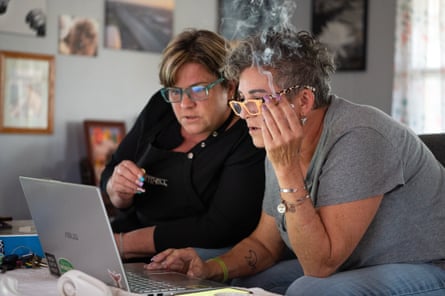
Diana Giffin, left, and Colleen Gartner prepare the agenda for the HOA meeting at Down Yonder.
Tenant advocates and activists have also criticized Zell for pouring money into opposing legislation for tenant protections, including $5.3m against a proposition that aimed to enact rent control in California. (It was defeated.)
“The way that we’ve historically always looked at Sam Zell is he really was a harbinger of doom in terms of the manufactured housing sector,” said Kevin Borden, executive director of Manufactured Housing Action, a national organization for mobile home residents. He attributed the founding of the organization in 2010 as a response to numerous complaints from residents at ELS communities. “His, for lack of a better term, leadership in the investment space in the manufactured housing sector then created the trend that we are truly struggling with today.”
Borden linked Zell to the influx of Wall Street investment into manufactured home communities. Owing to his success, Zell does indeed appear to have inspired others to invest in mobile homes. There are even “boot camps” for entrepreneurs who would like to follow in his footsteps.
But none has drawn as much opposition as Zell himself.
Several Down Yonder residents told me about their problems with their landlord recently, on a typical sunny day in Florida. Gartner has a light blue caravan home on the corner a few blocks into the park, where she lives with her service dog, Munfred, a small gray poodle mix. Although Down Yonder is technically intended for over-55s, 20% of residents – including Gartner – are permitted to be younger.
“I’m disabled,” she said. “I’ve had 13 spinal surgeries. My income is never going to increase. Currently, I pay $900 a month for my house to sit here and get nothing for it,” she said, referring to the lack of maintenance, upkeep and state of amenities.
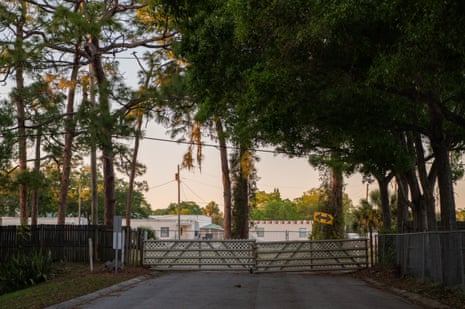
The back gate at Down Yonder is held up by zip ties. This is just one of the many issues residents want fixed.
This year, residents received a 7.5% rent hike after rents rising an average of 4.4% over the past five years. They are now being charged separately for water and sewage, which used to be included with the lot rent.
In November, more than 200 residents sent a notarized petition to ELS opposing the cost increases. Gartner herself recently received a $2,500 estimate for cutting trees on her property, though residents argue this should be the park’s responsibility as it owns them.
Gartner and other residents shared dozens of photos documenting issues of disrepair, neglect and flooding.
Clogged storm drains cause flooding that traps residents whenever there is significant rain. They describe frequent water shutoffs due to leaks, crumbling roads and a lack of upkeep of amenities and common areas. Seniors face difficulties entering the clubhouse as there are no access ramps and automatic doors, while restrooms and pool areas are not easily accessible by wheelchair, all of which they say violates the Americans with Disabilities Act. Drug users utilize the park’s common areas, they add, which ELS attributes to the park’s close proximity to unhoused encampments.
Like Gartner, Dagmar Benedik, 70, has been hit with an eviction notice for refusing to pay rent, alleging the park is violating the state law requiring landlords to maintain properties. Benedik moved to the park five years ago from Canada, where she had emigrated from Czechoslovakia.
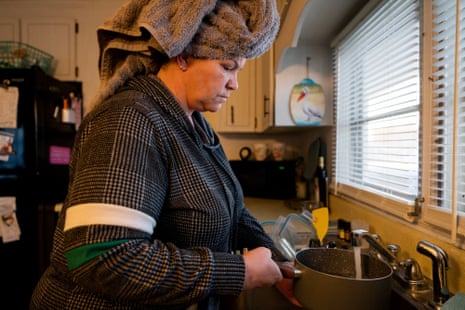
Diana Giffin fills pots with water before the water is turned off at Down Yonder at 10am for approximately four hours to address plumbing issues.
“Services have gone from bearable to insanely unbearable with cheap people who don’t do anything for us. And we really have no recourse,” she said. “We are rebels, we’re not going to roll over.”
The rising costs are particularly hard for residents on fixed incomes relying on social security benefits, she said. The average social security benefit is about $1,782 per month, and lot rents now account for about half of that. Benedik deals with flooding and sand in her tap water and collects multiple bags of leaf litter on her property each week because the park does not, though it is responsible for maintenance of the grounds.
Like Gartner, Diana Giffin, the third rent holdout, was enticed to move to Florida to get out of the cold weather, and to make a fresh start after a divorce. She left New York in May 2022 with her developmentally disabled son, Nicholas.
Upon moving in, Giffin said she noticed issues with the pool such as the lack of a Hoyer lift for seniors with movement impairments, and a leaking air conditioner that posed a fall hazard by the entrance of the pool. She also criticized the recent rent hike and water fees.

Diana Giffin uses bottled water to clean her hand after slicing an avocado at her home.
“I’m still trying to make changes and help the elderly and help the disabled in our community. If we don’t do this, they’re just being taken advantage of,” said Giffin. “It’s hell with all that’s transpired.”
Ruzhdi Leka, 73, and Zyhrije Leka, 67, moved into Down Yonder from New York in March 2022. According to their daughter, Iba, who spoke for her parents as their native language is Albanian and they are not fluent in English, they’ve been harassed by property management since they moved into the park.
“Anytime that they had anything to say, they usually would do it when I wasn’t around, and the encounters were always aimed at my father because they knew about my father’s condition,” said Iba. (Ruzhdi is recovering from a stroke and has Alzheimer’s.) “I’ve seen my father cry here at this place far more than ever in my life.”
Staff have shouted at her father for planting flowers in his yard, which is not permitted, she said, and has refused to assist with maintenance issues, such as a dilapidated home foundation that has caused her parents to fall.
“My mom survived two different wars, and she said during the wars they had a place to run to evacuate, but here, this is our home, where do we go? It broke my heart completely,” added Leka. “I am terrified to leave my parents here.”
The Down Yonder property manager referred a request for comment to ELS, which denied allegations of harassment by management and disputed the residents’ characterizations of conditions at the park.
A spokesperson said in an email: “Management enjoys a professional relationship with residents, including Ms Giffin, Ms Gartner and Ms Benedik. Management has, on occasion, needed to deliver notices to these residents regarding various issues. We regret that any resident may interpret the delivery of routine notices to be ‘harassment’.”
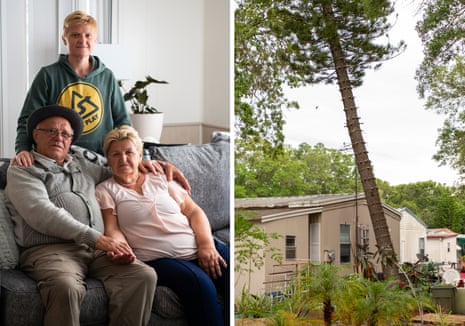
Ruzhdi Leka,73, and Zyhrije Leka, 67, had their daughter, Iba Leka, move in with them after Ruzhdi experienced harassment and bullying from the park management staff for planting flowers in his garden. He and his family were told they couldn’t plant flowers because the lot belongs to the mobile home park. However, the mobile home park won’t take care of the tree that is leaning over their home.
ELS also denied maintenance complaints, adding that drainage issues were the responsibility of municipal authorities and were being addressed. Residents are responsible for maintaining landscaping on their home sites, the company said. It acknowledged that it now charges separately for water and sewage, but said it reduced rents before tacking on these additional costs.
The firm added that it was renovating clubhouse restrooms and addressing termite damage in the clubhouse, and the work will be completed later this year.
The problems at Down Yonder sound familiar to other tenants of Zell-affiliated companies. There have been numerous reports over the years of these firms hiking rents and fees at mobile home parks, significantly affecting seniors on fixed incomes.
“They have an investment approach to communities designed to be as extractive of profit as possible. Significant rent increases, reduction in staffing by transitioning as much as possible from on-site staff to regional staff, shuttering amenities, reduction in maintenance,” said Dave Anderson, executive director of the National Manufactured Home Owners Association.
“Their strategy seems to be entirely centered around profit maximizing, raising the rent as much as possible and looking at every category at which there are expenses and keep[ing] them down.”
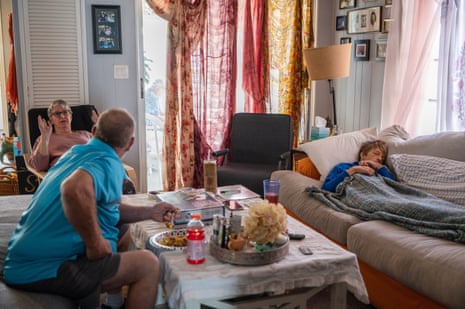
Dagmar Benedik, left, talks to Mike Keith as Nicholas Hallock takes a nap on the couch at Colleen Gartner’s home.
In 2014, a jury awarded a record $111m to residents of a mobile trailer park in San Jose, California, owned by ELS for its failure to maintain the park. The lawsuit argued that property managers were incentivized through a bonus structure to forgo maintenance. Amid appeals, the case was later settled for just under $10m.
In 2019, a Denver ABC News affiliate reported on residents at Holiday Hills mobile home park facing significant hikes in rent and fees, including a 77-year-old resident who had to return to work to cover the increases.
And in May 2022, a court in Washington DC ordered Equity Residential Management, an apartment property corporation belonging to Zell’s investment group, to pay nearly $2m to victims of illegal rent hikes.

Dagmar Benedik speaks to a neighbor outside their homes. Benedik moved to the mobile home park in 2017 and has experienced continuous issues with the park. She sometimes rakes up to 10 bags of leaves a week.
Other suits are pending. Residents at Heritage Plantation mobile home park in Vero Beach, Florida, filed a lawsuit over allegations the company had refused to maintain and repair the property. A class-action lawsuit has been filed in California against Equity Residential for overcharging for rental background checks.
There have also been allegations of harassment by property managers. At Bonanza Village, a mobile home park owned by ELS in Las Vegas, 37 residents signed a petition alleging harassment by the property manager, including claims of unfair and targeted enforcement of park rules.
One resident, Christine Needham, claimed the manager harassed her to the point that she sold her mobile home for a fraction of its cost, leaving the park she lived in for 25 years in May 2022.
“It’s taken me almost a year to feel safe again in my house,” said Needham. “I now live eight miles north and I’m still scared. I can’t go back to visit my friends in the park because I’m afraid of him and he’s threatened people who visited me.”
Needham claimed that he began threatening to evict her for feeding feral cats in the park, criticized her for having a Black Lives Matter sign on her property, and that he would park his truck outside her house early in the mornings while he spoke on the phone, which she believed was an attempt to intimidate her. (A friend of Needham’s, who asked to remain anonymous as they are a current resident and fear retaliation, also describes having observed this.) Needham’s attempts to raise the complaints with the district manager went nowhere, she said.
“It’s not a very nice mobile home park and it was going downhill,” said Needham, referring to rising rents and poorly maintained amenities. “They get their money and they ruin lives. I was homeless as a kid, so that house meant everything to me.
The property manager could not be contacted for comment. ELS said he had resigned.
A current resident at Bonanza Village who asked to remain anonymous for fear of retaliation, said the departure of the property manager was very recent.
“Instead of a manager, he was more of a dictator, because we’re under his rules,” they said.
ELS denied Needham’s claims and allegations of harassment. It said in an email: “Ms Needham chose to sell her home in the community in June 2022 and relocated. Management was not involved in the sale and we have no knowledge of the selling price of her home. The only interaction management had with Ms Needham during the last nine months of her residency was the delivery of three notices, each of which was handled professionally and in accordance with local laws.”
People play bingo inside the manor house. The park management keeps the thermostat for the air conditioning under lock and key so residents cannot change the temperature.
ELS attributed the petition against the property manager to residents being displeased after being cited for violations discovered in an annual community inspection. “Enforcing community rules and regulations improves the curb appeal of the community and helps to maintain the value of homes for homeowners in the community,” a spokesperson said.
Over 1,500 miles away from Down Yonder is another ELS mobile home park, the Cimarron mobile home community in Lake Elmo, Minnesota. It may not have the same temperate weather as Tampa Bay, but the families who live there say it has offered an affordable way to rent or own a home. They are attempting to take their fight with ELS to the next level to address rental increases and what they say has been degrading conditions of the park.
Homeowner Brey Mafi said amenities had been reduced or closed off since the pandemic, that flooding is a regular occurrence in the park, snow removal through the winter isn’t properly conducted and the community isn’t properly lit at night. She claimed the streets are crumbling with potholes and rarely cleaned.
She provided a PowerPoint presentation with dozens of photos outlining disrepair at the mobile park. Park management, she added, had responded dismissively to resident complaints.
“Sam Zell is doing well,” said Mafi, who lives with her husband and daughter. “They’re getting shareholder dividends paid out. There’s growth, yet we can’t get some lights here just to walk the streets safely.”
But while the amenities have been closed off and maintenance lags, lot rent fees have regularly been increased, including a 7.75% increase this year, twice as high as the year prior. Lot rents are now over $900 a month for many residents.
Mafi serves on the residents association at the park, which she said has retained legal counsel, because residents have made numerous complaints to the state attorney general’s office about issues at the mobile home park. The Minnesota attorney general’s office did not confirm or deny any current investigation.
John Murphy has lived in Cimarron since 2005 and for most of that time the property management left residents alone. But recently property managers began enforcing policies such as parking restrictions that result in residents getting their cars towed and having to pay towing fees. Murphy and others consider this a form of harassment. ELS has claimed the parking enforcement is not a new rule and is for emergency vehicle access.
“They’re just a large corporation that buys this place up, they’re pulling money out of it, they’re not reinvesting much back into it, and it’s making us feel like we’re just a bunch of milk cows rather than customers,” said Murphy. “They don’t talk to the residents, and when they do it’s usually ugly or dictating.”
ELS denied claims of poor maintenance and complaints about management, claiming the park was currently in year two of a three-year project to repave the roads at Cimarron Park and that potholes are filled every spring. The company denied any drainage issues, but noted a preventive maintenance plan to clear stormwater channels at the property had been implemented. It claimed that amenities such as the golf course were open and maintained on a regular basis and that the playground was being replaced.

A woman walks past a ‘for sale’ sign for a mobile home at Down Yonder.
“We make it a priority to regularly meet with residents and discuss any issues they have, including rent increases,” the company said. “Increases and rent levels are in line with those of comparable housing options in the area,” added a spokesperson.
Residents hope the attorney general will prove ELS wrong.
“It’s sickening. It’s just misery and people will tell me all the time, I feel like I’m in prison here,” said Mafi. “What did I do to pay money to these people every month to deserve this? It is by far and large the worst consumer experience I have ever had in my life. They’re slumlords and there’s no way around it.”




